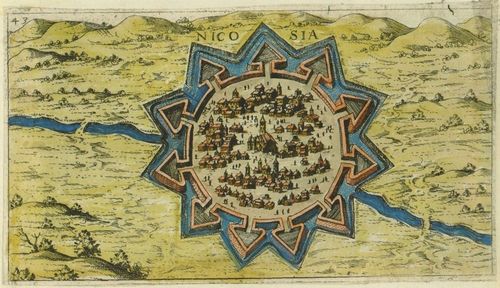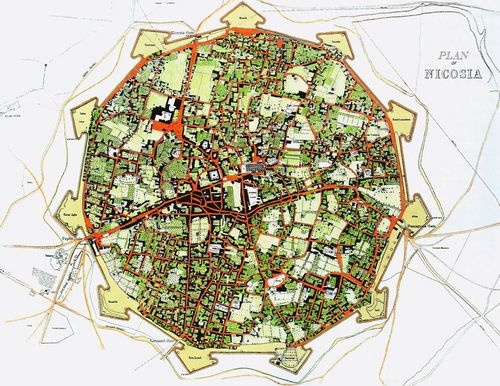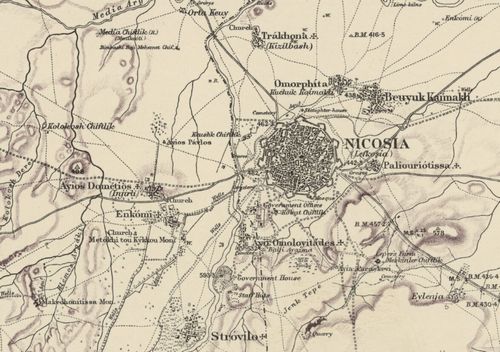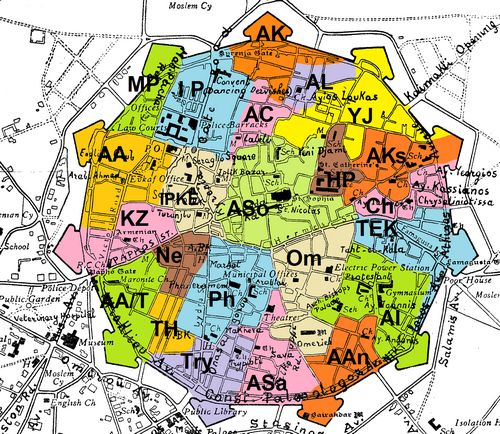The History of Nicosia
This page will look, in a little more detail, at the history of Nicosia from 1489 when the Venetians ruled the island to the period just after the end of World War 2.
When under Venetian control, Cyprus became the most important port of call for the Venetian galleys and was the centre for their trading in the East.
Nicosia was the administrative centre and the seat of the Venetian Governor.
In 1567, the Venetians decided to update the earlier walls built by the Franks with ones that covered a much smaller area that could be more easily defended.

The new walls, only partially completed by 1570, had the shape of a star with eleven bastions and only three gates.
Only the lower levels were constructed in stone; the upper section could only be considered glorified earthworks.
Between July and September 1570, Nicosia was besieged and then captured by Ottoman forces.

The main Latin (Catholic) churches were converted into mosques.
Three hundred years of troubled Ottoman rule had begun.
On the 5th July, 1878, the administration of the island was officially transferred to the United Kingdom.
The Union Jack was raised in the presence of Vice-Admiral Lord John Gray.

Greek Priests blessing the British Flag at Nicosia. Illustration for The Illustrated London News, 21 September 1878.
Image licensed from.....© Look and Learn
Click for a larger image in a new window

At the time of the British occupation, Nicosia was still contained entirely within its Venetian Walls.
The city was full of private gardens and amply supplied with water carried to public fountains through aqueducts but the streets remained unpaved and just wide enough for a loaded pack animal.
In June 1882, the municipal limits were extended to “a circle drawn at a distance of five hundred yards beyond the salient angles of the bastions of the fortifications”.
In the following years, the old city within the walls was increasingly given over to shops and workshops. In residential terms, it had become a lower income area.
Old people tended to stay in the old city, building houses for their daughters outside the walls.

This section of Kitchener's 1885 survey shows how little development there was outside the walls.
Several nearby small villages would, in the years to follow, become the suburbs of a much larger city.
Click the image or this link for a larger view (in a new window)
Reproduced with the permission of the National Library of Scotland.

In 1946 there were 10,330 Turkish Cypriots, 20,768 Greek Cypriot and 3,387 Others living in the twenty three districts that comprised Nicosia within the walls.......click the link for the names of the colour coded districts (opens in a new window).

No district was entirely Greek or Turkish; all were mixed to some extent.
The areas shaded blue were predominantly Greek with a mix of, for example, 2224 Greek to 152 Turkish (District of Tophane....AA/T).
The areas shaded red were predominantly Turkish with a mix of, for example , 1094 Turkish to 107 Greek (District Ak Kavuk....AK)
The areas shaded purple were more equally mixed between Greek, Turkish and others, for example, 116 Greek, 232 Turkish and 208 others (District Korkut Efendi & Iplik Pazari....IPKE)
Additionally in 1946, in the quarters immediately outside the walls lived a further 10,000 inhabitants.
In the outskirts of the old city there were nine villages (now becoming suburbs), where a total of 18,839 Greek & Turkish Cypriots were living.